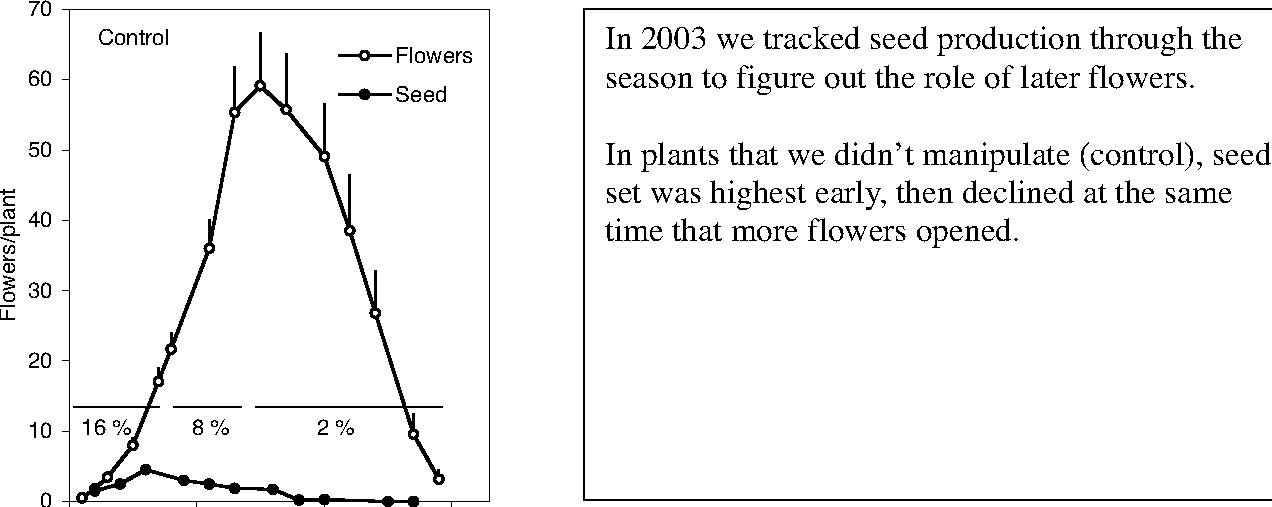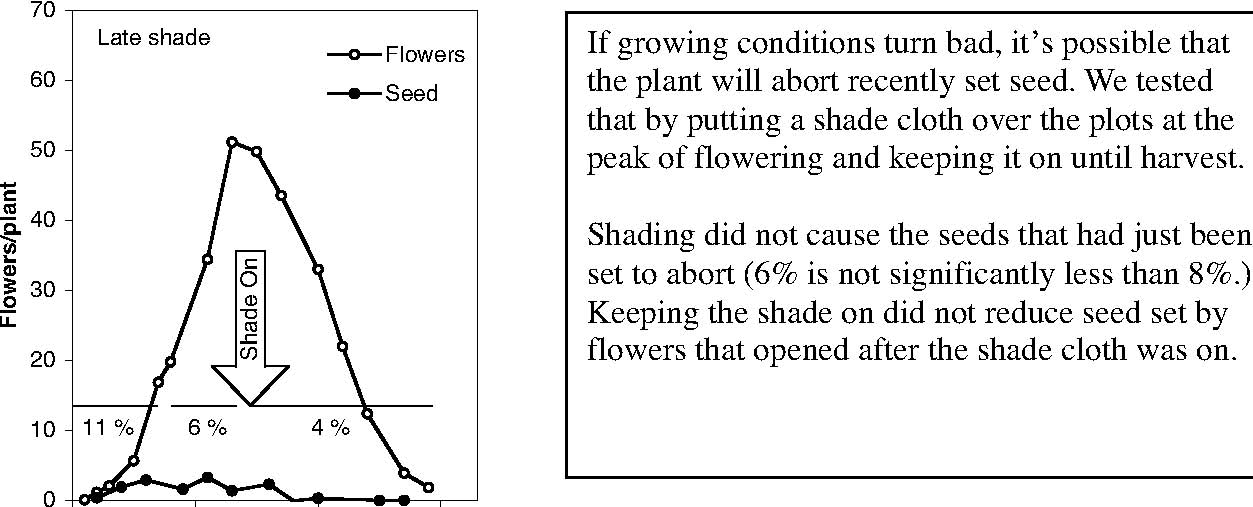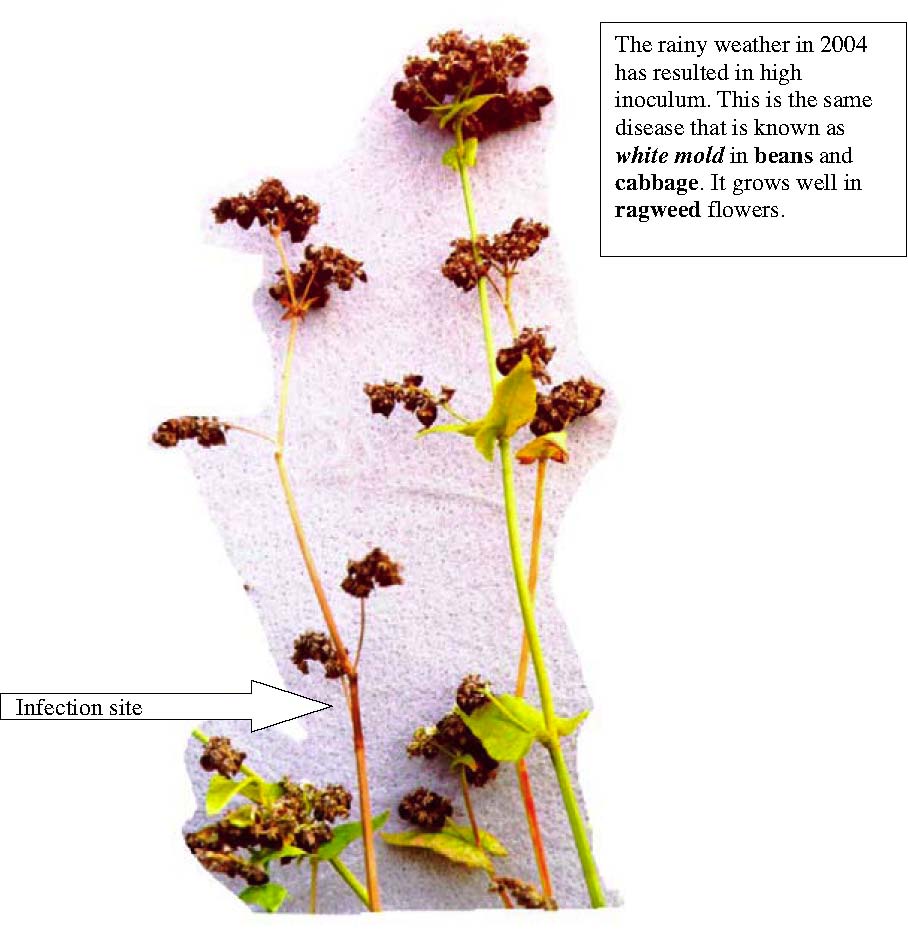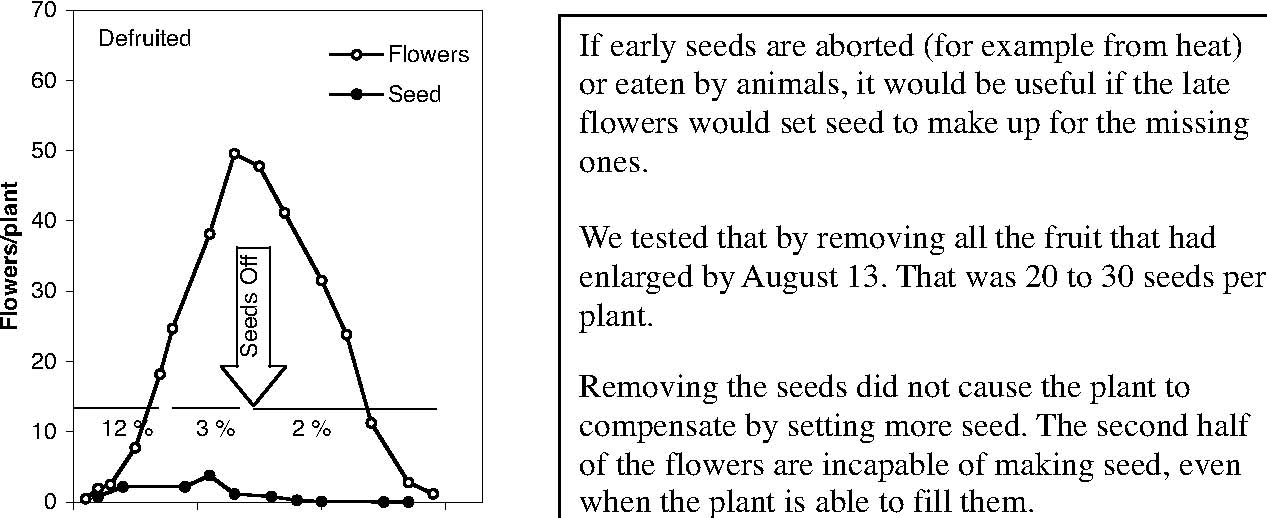CORNELL
UNIVERSITY
|
New York State Agricultural Experiment
Station
|
||||||||
|---|---|---|---|---|---|---|---|---|
|
10th Annual Northeast Buckwheat Field
Day
|
||||||||
| August 25, 2004 | ||||||||
|
New York Crop Research Facility, Batavia
|
||||||||
| Organized by Thomas Björkman | ||||||||
|
Dept. of Horticultural Sciences NYSAES, Cornell University. Hosted by ACDS Research |
||||||||
| 1:00 |
Schedule Introductions |
|||||||
| 1:15 |
Effect of 2004 weather on establishment and growth Grower perspectives |
|||||||
| 1:30 | Stem rot | |||||||
| 1:45 | Fate of late flowers: no second chances | |||||||
| 2:15 | Break | |||||||
| 2:00 | In field demonstrations: Plant population and nitrogen | |||||||
| 2:30 | Excess fertility | |||||||
| 3:00 | Human health | |||||||
The PDF version of this document has graphs and clearer organization.
Return to Main buckwheat page
The season so far
Wet
Planting in many fields was delayed. Sometimes buckwheat was planted in fields that were originally intended for some other crop.
Field preparation is critical for buckwheat. Wet soils made that difficult. Wet soils compact easily. A disk can easily create a compacted layer just below the seed that restricts percolation, and promotes seed rot. Rapid germination is important, and happens best with shallow seeding. If the soil has big lumps, it is hard to cover the seed. Preventing the lumps is the key. Breaking up lumps that formed because the ground was worked too wet just increases the risk of crusting.
Buckwheat responds well to sufficient water. Their root system is designed for frequent rains or for deep soils that hold a lot of water. Where initial establishment was successful, this year could produce good crops.
Exploding seeds. When seeds are in the dough stage, rains can cause them to swell and split. The white starch is visible on the outside of a split and empty hull. It is now known how much crop loss results from this curious effect.
Stem rot. The season has brought high inoculum levels of the pathogen. In beans and cabbage it is known as white mold. It also grows well in ragweed. The high inoculum and good conditions for disease in buckwheat predict significant occurrence. (See next page)
Not too hot
Heat blasting is a concern if the temperature is high during flowering. High temperatures cause the flowers or new fruit to abort. This year, early August has been temperate. The temperature has been in the low 70's. Only August 3 was about 85 degrees with a low of 70. No crop should have been lost to this malady.
Good buckwheat crops depend on rapid growth to the 4-leaf stage. By the time the plants are at the 4-leaf stage, the crop is more resistant for three reasons.
- Seedling is much less sensitive to excess water.
- The soil is protected from direct hits by raindrops.
- The soil surface is shaded so weed seedlings are suppressed.
Buckwheat needs a good seedbed and moist, but not wet soil, with lots of air. Heavy rain in the two weeks after seeding buckwheat often have a devastating effect on establishment. Likewise, low spots in the field, or compacted areas will often grow poorly.
Hours in mud
Buckwheat is much more sensitive to waterlogging than some other crops with similar seed size. Seeds of each type were placed in a mud bath for various periods to see how much they could take before germination was depressed. Buckwheat seeds did not even tolerate 2 hours.
See PDF version of this document for the picture!
Stem RotStem rot (Sclerotinia sclerotiorum) can sweep through a field near harvest. It begins as small brown spots on the stem. The stem then turns pale and dehydrated. Seeds fall off easily and eventually the stem topples. Once toppled, the plants are hard to find. The disease may never be discovered. The remedy for the disease is timely harvest. The stems appear to weaken when the seeds are fairly mature. Leaving a field with this disease unharvested may result in substantial undetected yield loss.
|
 |
 |
|
|
Assessing seed set
The first flowers are on node 4 and 5. The higher parts of the plant grow out later. If there is light enough low in the plant, branches will form from node 3 and lower.
Under ideal conditions, there should be a lot of developing seed on the short branches on node 4 and 5. More seeds will form later on the upper clusters and on the upper parts of the branches.
Heat blasting early: dead flowers on node 4 and 5, but no seeds. New kernels developing higher and lower on the plant.
High abortion: There are many false kernels Seeds that will abort look lighter and more transparent than those that will fill.
Seed fill has just begun in a July 3 planting in Geneva. In Batavia, the planting was July 10.
For good yield, plants with one branch and reaching the canopy should make 30 to 40 seeds.
Timeline of seed development
4 days after pollination: tip of hull is longer than sepals.
10 days after flowering: The hull is full length, and show the first signs of swelling.
14 days after flowering: the seed is full size, but filled with mostly water. 18 days after flowering: the seed begins to turn brown.
Population
Buckwheat is able to adjust to considerable variation in plant population. In research trials, there has been little yield response to variation in seeding rate from 30 to 80 lb/ac. The range is likely to be smaller on any given farm.
Seed cost Keeping seed costs down usually means trying to reduce the seeding rate. Smaller seeds can also reduce the cost for a given plant population. These factors are important mainly for raising cover crops or producing seed for local mills and cover crop use.
Plant growth
Branching At high density, buckwheat produces only a main stem and one or two side clusters. At low density, buckwheat branches profusely. The difference in weight between an average plant in a normal field and an isolated plant in the same field can be 20-fold.
Lodging At high density, the unbranched growth and low lignification of the stems make the plants more susceptible to lodging.
Small plants In a low fertility field, plants that grow only 18 to 24” need a higher population to cover the ground. Covering the ground helps both with weed control and capturing enough light. It is usually worthwhile to correct the problem causing the plants to be so small.
Weeds
There are three ways that buckwheat helps reduce weeds.
- Tillage in mid-summer harms perennial weeds.
- Shading suppresses the growth of all smaller plants.
- Allelopathy slows root growth of some weeds.
Early establishment is the key to suppressing weeds. Buckwheat must overtop the weeds to suppress them. Dry soil at planting slows buckwheat growth and can give weeds a head start. Cold, wet conditions after planting favor the cool-season weeds and inhibits buckwheat. Finally, an inadequate seeding rate, or gaps in the planting can allow weeds through. Weed seeds germinate under buckwheat, so the seed bank is depleted.
Nitrogen fertility
Buckwheat does not require much nitrogen. For many fields producing other crops, the amount of nitrogen is sufficient to produce a good crop.
Do you need more nitrogen?
Buckwheat may respond to nitrogen in fields that

